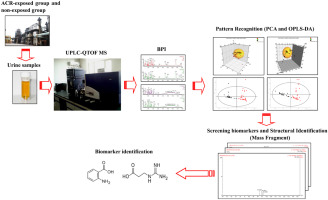当前位置:
X-MOL 学术
›
Arch. Biochem. Biophys.
›
论文详情
Our official English website, www.x-mol.net, welcomes your feedback! (Note: you will need to create a separate account there.)
A urinary metabolomic study from subjects after long-term occupational exposure to low concentration acrylamide using UPLC-QTOF/MS.
Archives of Biochemistry and Biophysics ( IF 3.9 ) Pub Date : 2020-01-23 , DOI: 10.1016/j.abb.2020.108279 Sheng-Yuan Wang 1 , Dan Han 2 , Yu-Lin Pan 1 , Cui-Ping Yu 1 , Xiao-Rong Zhou 1 , Rui Xin 1 , Rui Wang 1 , Wei-Wei Ma 3 , Chao Wang 4 , Yong-Hui Wu 1
Archives of Biochemistry and Biophysics ( IF 3.9 ) Pub Date : 2020-01-23 , DOI: 10.1016/j.abb.2020.108279 Sheng-Yuan Wang 1 , Dan Han 2 , Yu-Lin Pan 1 , Cui-Ping Yu 1 , Xiao-Rong Zhou 1 , Rui Xin 1 , Rui Wang 1 , Wei-Wei Ma 3 , Chao Wang 4 , Yong-Hui Wu 1
Affiliation

|
Because long-term occupational exposure to low concentrations of acrylamide (ACR) has the potential to cause neurological damage, it is important to identify biomarkers that can be used to evaluate this risk. In the present study, urine metabolomics of the ACR-exposed and non-exposed groups to identify potential metabolites was carried out using ultra high performance liquid chromatography coupled with quadrupole time of flight mass spectrometry. Serum biochemical indexes of the exposed and non-exposed groups were also determined. Principal component analysis showed a differential separation between exposed group and non-exposed group and a total of 7 metabolites were identified in positive and negative ionization modes; Area under curve of anthranilic acid, β-guanidinopropionic acid and mesobilirubinogen were 0.980, 0.843 and 0.801 respectively and these metabolites showed high sensitivity and specificity. The 13 biochemical indexes were divided into three classes based on physiological functions. Only biomarkers of dysregulated liver function including alanine aminotransferase, aspartic transaminase, total bilirubin, direct bilirubin and triglyceride were significantly higher in the exposed group than in the non-exposed group. This study identifies important related metabolic changes in the bodies of workers after long-term occupational exposure to low concentration ACR and suggests new biomarkers of nervous system injury caused by ACR. The study also provides a sound basis for exploring the biochemical mechanisms and metabolic pathways of nervous system toxicity caused by ACR.
中文翻译:

使用UPLC-QTOF / MS对长期职业性接触低浓度丙烯酰胺的受试者进行的尿代谢组学研究。
由于长期在低浓度的丙烯酰胺(ACR)中进行长期职业暴露有可能引起神经系统损害,因此确定可用于评估该风险的生物标记很重要。在本研究中,使用超高效液相色谱结合四极杆飞行时间质谱法进行了ACR暴露组和未暴露组的尿液代谢组学研究,以确定潜在的代谢物。还确定了暴露和未暴露组的血清生化指标。主成分分析表明,暴露组和未暴露组之间存在差异,正离子和负离子化模式下共鉴定出7种代谢物。邻氨基苯甲酸,β-胍基丙酸和中胆红素原的曲线下面积分别为0.980、0.843和0。这些代谢物分别为801和高灵敏度和特异性。根据生理功能将13种生化指标分为三类。暴露组中只有丙氨酸转氨酶,天冬氨酸转氨酶,总胆红素,直接胆红素和甘油三酸酯等肝功能失调的生物标志物显着高于未暴露组。这项研究确定了长期职业性接触低浓度ACR后工人体内重要的相关代谢变化,并提出了由ACR引起的神经系统损伤的新生物标记。该研究还为探索由ACR引起的神经系统毒性的生化机制和代谢途径提供了良好的基础。根据生理功能将13种生化指标分为三类。暴露组中只有丙氨酸转氨酶,天冬氨酸转氨酶,总胆红素,直接胆红素和甘油三酸酯等肝功能失调的生物标志物显着高于未暴露组。这项研究确定了长期职业性接触低浓度ACR后工人体内重要的相关代谢变化,并提出了由ACR引起的神经系统损伤的新生物标记。该研究还为探索由ACR引起的神经系统毒性的生化机制和代谢途径提供了良好的基础。根据生理功能将13种生化指标分为三类。暴露组中只有丙氨酸转氨酶,天冬氨酸转氨酶,总胆红素,直接胆红素和甘油三酸酯等肝功能失调的生物标志物显着高于未暴露组。这项研究确定了长期职业性接触低浓度ACR后工人体内重要的相关代谢变化,并提出了由ACR引起的神经系统损伤的新生物标记。该研究还为探索由ACR引起的神经系统毒性的生化机制和代谢途径提供了良好的基础。暴露组的总胆红素,直接胆红素和甘油三酯明显高于未暴露组。这项研究确定了长期职业性接触低浓度ACR后工人体内重要的相关代谢变化,并提出了由ACR引起的神经系统损伤的新生物标记。该研究还为探索由ACR引起的神经系统毒性的生化机制和代谢途径提供了良好的基础。暴露组的总胆红素,直接胆红素和甘油三酯明显高于未暴露组。这项研究确定了长期职业性接触低浓度ACR后工人体内重要的相关代谢变化,并提出了由ACR引起的神经系统损伤的新生物标记。该研究还为探索由ACR引起的神经系统毒性的生化机制和代谢途径提供了良好的基础。
更新日期:2020-01-24
中文翻译:

使用UPLC-QTOF / MS对长期职业性接触低浓度丙烯酰胺的受试者进行的尿代谢组学研究。
由于长期在低浓度的丙烯酰胺(ACR)中进行长期职业暴露有可能引起神经系统损害,因此确定可用于评估该风险的生物标记很重要。在本研究中,使用超高效液相色谱结合四极杆飞行时间质谱法进行了ACR暴露组和未暴露组的尿液代谢组学研究,以确定潜在的代谢物。还确定了暴露和未暴露组的血清生化指标。主成分分析表明,暴露组和未暴露组之间存在差异,正离子和负离子化模式下共鉴定出7种代谢物。邻氨基苯甲酸,β-胍基丙酸和中胆红素原的曲线下面积分别为0.980、0.843和0。这些代谢物分别为801和高灵敏度和特异性。根据生理功能将13种生化指标分为三类。暴露组中只有丙氨酸转氨酶,天冬氨酸转氨酶,总胆红素,直接胆红素和甘油三酸酯等肝功能失调的生物标志物显着高于未暴露组。这项研究确定了长期职业性接触低浓度ACR后工人体内重要的相关代谢变化,并提出了由ACR引起的神经系统损伤的新生物标记。该研究还为探索由ACR引起的神经系统毒性的生化机制和代谢途径提供了良好的基础。根据生理功能将13种生化指标分为三类。暴露组中只有丙氨酸转氨酶,天冬氨酸转氨酶,总胆红素,直接胆红素和甘油三酸酯等肝功能失调的生物标志物显着高于未暴露组。这项研究确定了长期职业性接触低浓度ACR后工人体内重要的相关代谢变化,并提出了由ACR引起的神经系统损伤的新生物标记。该研究还为探索由ACR引起的神经系统毒性的生化机制和代谢途径提供了良好的基础。根据生理功能将13种生化指标分为三类。暴露组中只有丙氨酸转氨酶,天冬氨酸转氨酶,总胆红素,直接胆红素和甘油三酸酯等肝功能失调的生物标志物显着高于未暴露组。这项研究确定了长期职业性接触低浓度ACR后工人体内重要的相关代谢变化,并提出了由ACR引起的神经系统损伤的新生物标记。该研究还为探索由ACR引起的神经系统毒性的生化机制和代谢途径提供了良好的基础。暴露组的总胆红素,直接胆红素和甘油三酯明显高于未暴露组。这项研究确定了长期职业性接触低浓度ACR后工人体内重要的相关代谢变化,并提出了由ACR引起的神经系统损伤的新生物标记。该研究还为探索由ACR引起的神经系统毒性的生化机制和代谢途径提供了良好的基础。暴露组的总胆红素,直接胆红素和甘油三酯明显高于未暴露组。这项研究确定了长期职业性接触低浓度ACR后工人体内重要的相关代谢变化,并提出了由ACR引起的神经系统损伤的新生物标记。该研究还为探索由ACR引起的神经系统毒性的生化机制和代谢途径提供了良好的基础。


























 京公网安备 11010802027423号
京公网安备 11010802027423号